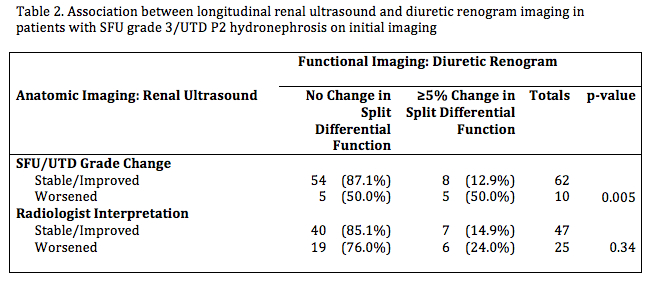The Correlation Between Serial Ultrasound and Diuretic Renography in Children with Unilateral High-Grade Hydronephrosis
Deborah L. Jacobson, MD1, Carl C. Flink, MD2, Earl Y. Cheng, MD1, Emilie K. Johnson, MD, MPH1, Elizabeth B. Yerkes, MD1, Max Maizels, MD1, Bruce W. Lindgren, MD1, Dennis B. Liu, MD1, Ilina Rosoklija, MPH1, Edward M. Gong, MD1.
1Lurie Children's Hospital/Northwestern University, Chicago, IL, USA, 2University of Cincinnati, Cincinnati, OH, USA.
PURPOSE: Serial renal ultrasound (RUS) is often used as a surrogate for functional renal imaging among patients followed for hydronephrosis. While we have previously demonstrated that renal function is uniformly preserved among newborns with postnatal Society of Fetal Urology (SFU) grade 3 hydronephrosis, it is unclear whether a lack of progression on serial RUS safeguards against loss of renal function. This study was performed to better characterize the association between findings on serial RUS and diuretic renography among children with unilateral high-grade hydronephrosis.
METHODS: We completed a retrospective cohort study of children aged <18 years with a history of unilateral SFU grade 3-4 (Urinary Tract Dilation [UTD] P2-3) hydronephrosis. All patients underwent at least 2 RUS and 2 diuretic renograms. Patients were excluded for comorbidities associated with bladder-level dysfunction or uninterpretable diuretic renograms (i.e. solitary kidney), or diuretic usage during only one RUS. Each RUS was paired with a contemporaneous diuretic renogram and compared with a subsequent study pair. All studies were reviewed by an independent, blinded diagnostic radiologist. For each patient, changes in degree of hydronephrosis were determined by either (1) change in SFU/UTD grade or (2) any change noted by the radiologist. These were compared with changes in diuretic renal imaging, with a ≥5% change in differential renal function (i.e. change from 50%:50% to 45%:55%) considered significant. Chi-squared and Spearman's correlation analyses were performed.
RESULTS: 85 patients aged 0.5 months-13.6 years (mean 11.8 months) were included in the final analysis. Patients were predominantly male (72.9%) and most had SFU grade 3/UTD P2 hydronephrosis (84.7%). Time between diuretic renograms ranged from 1-112.4 months (mean 19.7). Worsening hydronephrosis was noted in 10/85 patients (11.8%) by SFU/UTD grade and in 28/85 patients (32.9%) by radiologist interpretation. Split differential renal function decreased by at least 5% in 15/85 patients (17.7%). Changes in split differential function were significantly associated with corollary changes in SFU/UTD grade on RUS among all patients (p=0.004, Table 1) and among patients with SFU grade 3/UTD P2 hydronephrosis (p=0.005, Table 2). However, less substantial changes noted by the radiologist were not associated with diuretic renogram findings (p=0.21). Moreover, 10/70 (13.3%) patients with stable or improved SFU/UTD grade developed worsening renal function during the study period. When RUS and diuretic renogram were directly compared, the Spearman's correlation between these modalities was poor (r=0.24, CI [0.03-0.43]).
CONCLUSIONS: While substantial changes in RUS findings were associated with corollary changes on diuretic renogram, the overall correlation between imaging modalities was poor. However, it is important to note that 13.3% of children with SFU grade 3-4/UTD P2-3 hydronephrosis experienced a loss of renal function despite stable longitudinal RUS imaging. These findings are important to consider when counseling conservatively managed patients followed without diuretic renography.

Back to 2017 Program
